Training Manual: Implementing Person-Centred Practice
VerifiedAdded on 2023/01/10
|13
|2766
|60
AI Summary
This training manual provides guidance on implementing a person-centred approach in healthcare practice. It covers principles, challenges, and benefits of person-centred care.
Contribute Materials
Your contribution can guide someone’s learning journey. Share your
documents today.
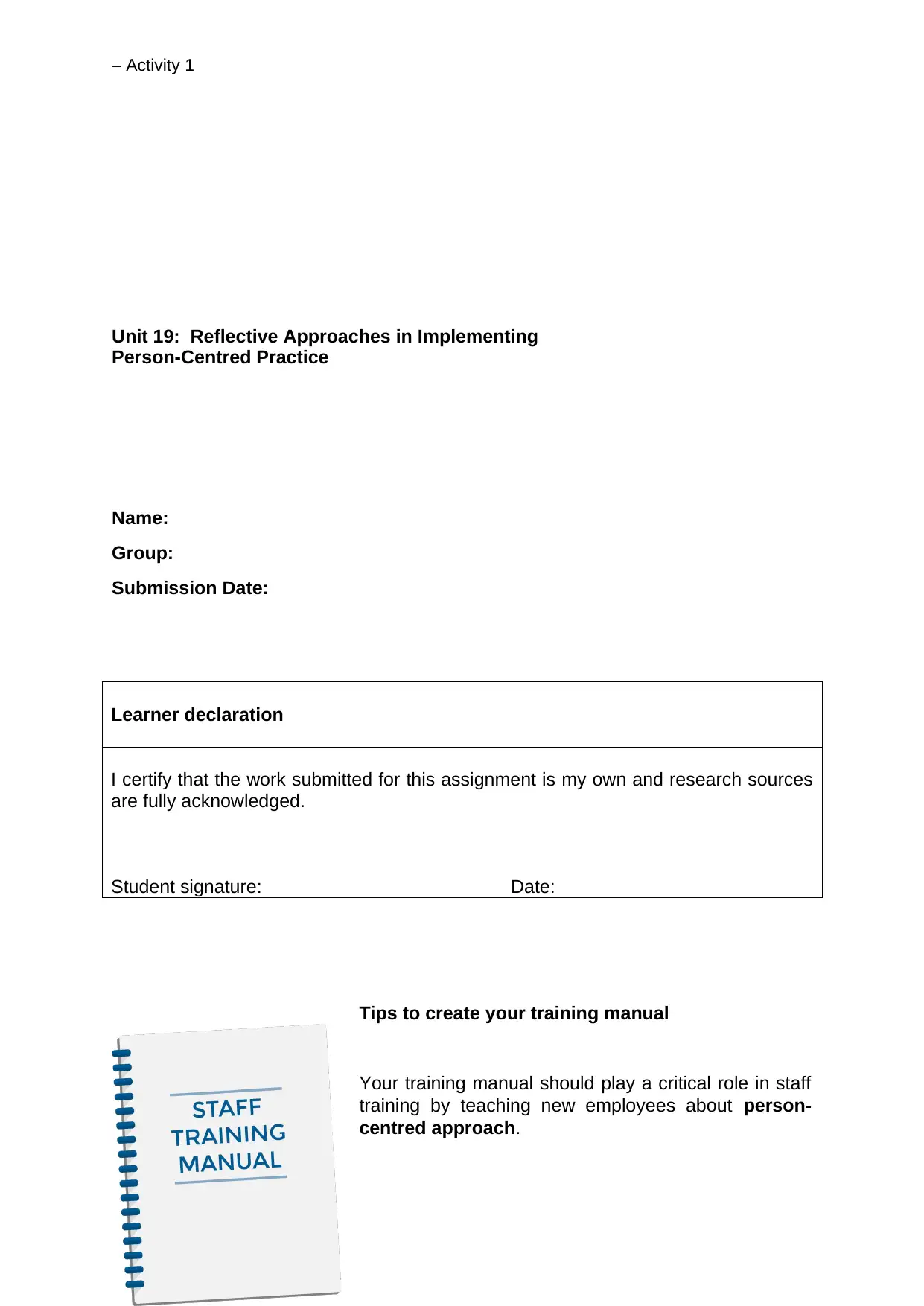
– Activity 1
Unit 19: Reflective Approaches in Implementing
Person-Centred Practice
Name:
Group:
Submission Date:
Learner declaration
I certify that the work submitted for this assignment is my own and research sources
are fully acknowledged.
Student signature: Date:
Tips to create your training manual
Your training manual should play a critical role in staff
training by teaching new employees about person-
centred approach.
Unit 19: Reflective Approaches in Implementing
Person-Centred Practice
Name:
Group:
Submission Date:
Learner declaration
I certify that the work submitted for this assignment is my own and research sources
are fully acknowledged.
Student signature: Date:
Tips to create your training manual
Your training manual should play a critical role in staff
training by teaching new employees about person-
centred approach.
Secure Best Marks with AI Grader
Need help grading? Try our AI Grader for instant feedback on your assignments.
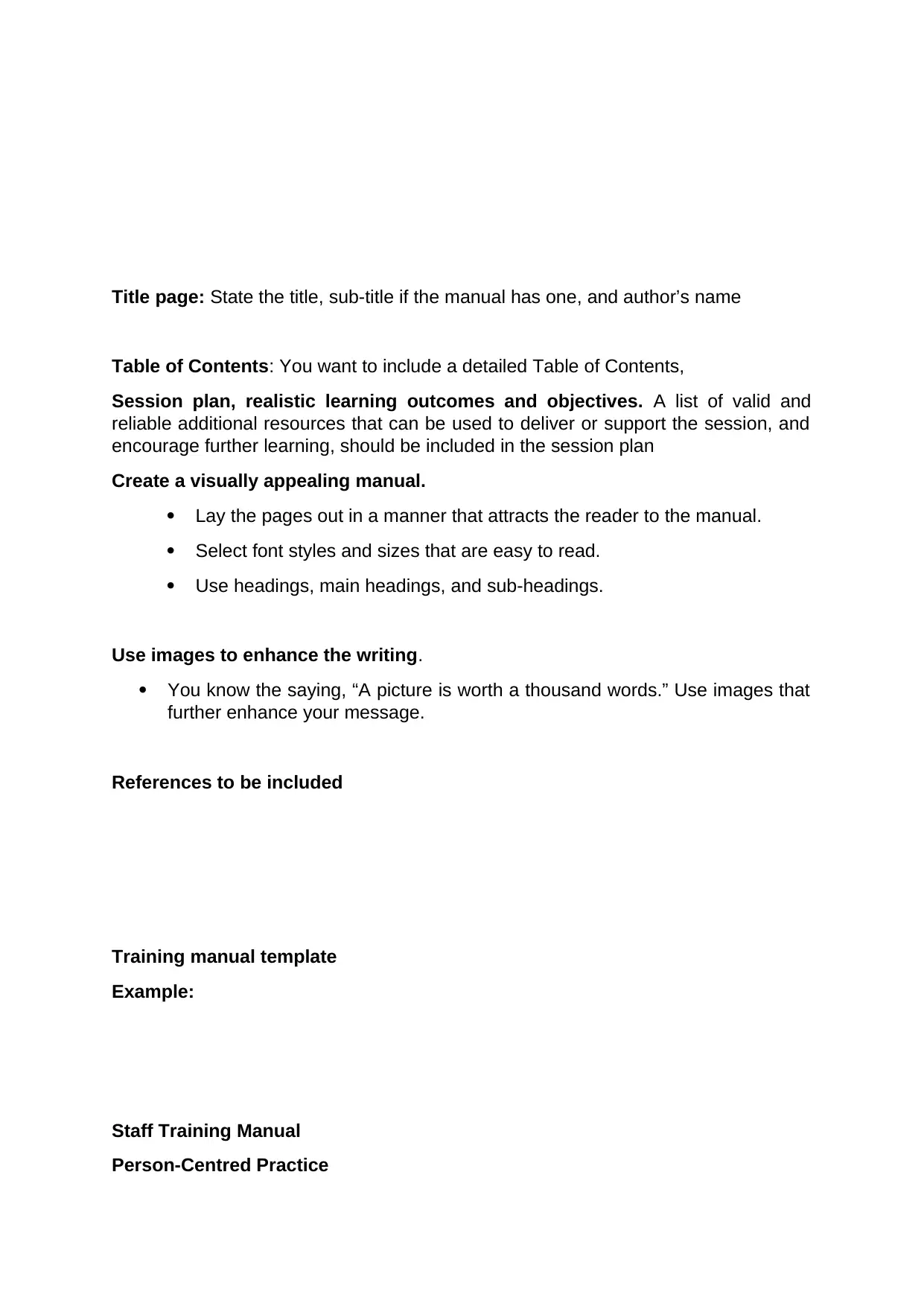
Title page: State the title, sub-title if the manual has one, and author’s name
Table of Contents: You want to include a detailed Table of Contents,
Session plan, realistic learning outcomes and objectives. A list of valid and
reliable additional resources that can be used to deliver or support the session, and
encourage further learning, should be included in the session plan
Create a visually appealing manual.
Lay the pages out in a manner that attracts the reader to the manual.
Select font styles and sizes that are easy to read.
Use headings, main headings, and sub-headings.
Use images to enhance the writing.
You know the saying, “A picture is worth a thousand words.” Use images that
further enhance your message.
References to be included
Training manual template
Example:
Staff Training Manual
Person-Centred Practice
Table of Contents: You want to include a detailed Table of Contents,
Session plan, realistic learning outcomes and objectives. A list of valid and
reliable additional resources that can be used to deliver or support the session, and
encourage further learning, should be included in the session plan
Create a visually appealing manual.
Lay the pages out in a manner that attracts the reader to the manual.
Select font styles and sizes that are easy to read.
Use headings, main headings, and sub-headings.
Use images to enhance the writing.
You know the saying, “A picture is worth a thousand words.” Use images that
further enhance your message.
References to be included
Training manual template
Example:
Staff Training Manual
Person-Centred Practice

– Activity 1
RAINBOW CARE HOME
Accommodation for persons who require nursing or personal care, Dementia,
Learning disabilities, Mental health conditions, Personal care, Physical disabilities,
Sensory impairments
Caring for adults 18+and over 65 yrs.
Table of contents:
RAINBOW CARE HOME
Accommodation for persons who require nursing or personal care, Dementia,
Learning disabilities, Mental health conditions, Personal care, Physical disabilities,
Sensory impairments
Caring for adults 18+and over 65 yrs.
Table of contents:

Purpose:
The purpose of this manual is to teach new members of staff how to implement a
person-centred approach in their practice.
Learning outcomes:
The purpose of this manual is to teach new members of staff how to implement a
person-centred approach in their practice.
Learning outcomes:
Secure Best Marks with AI Grader
Need help grading? Try our AI Grader for instant feedback on your assignments.
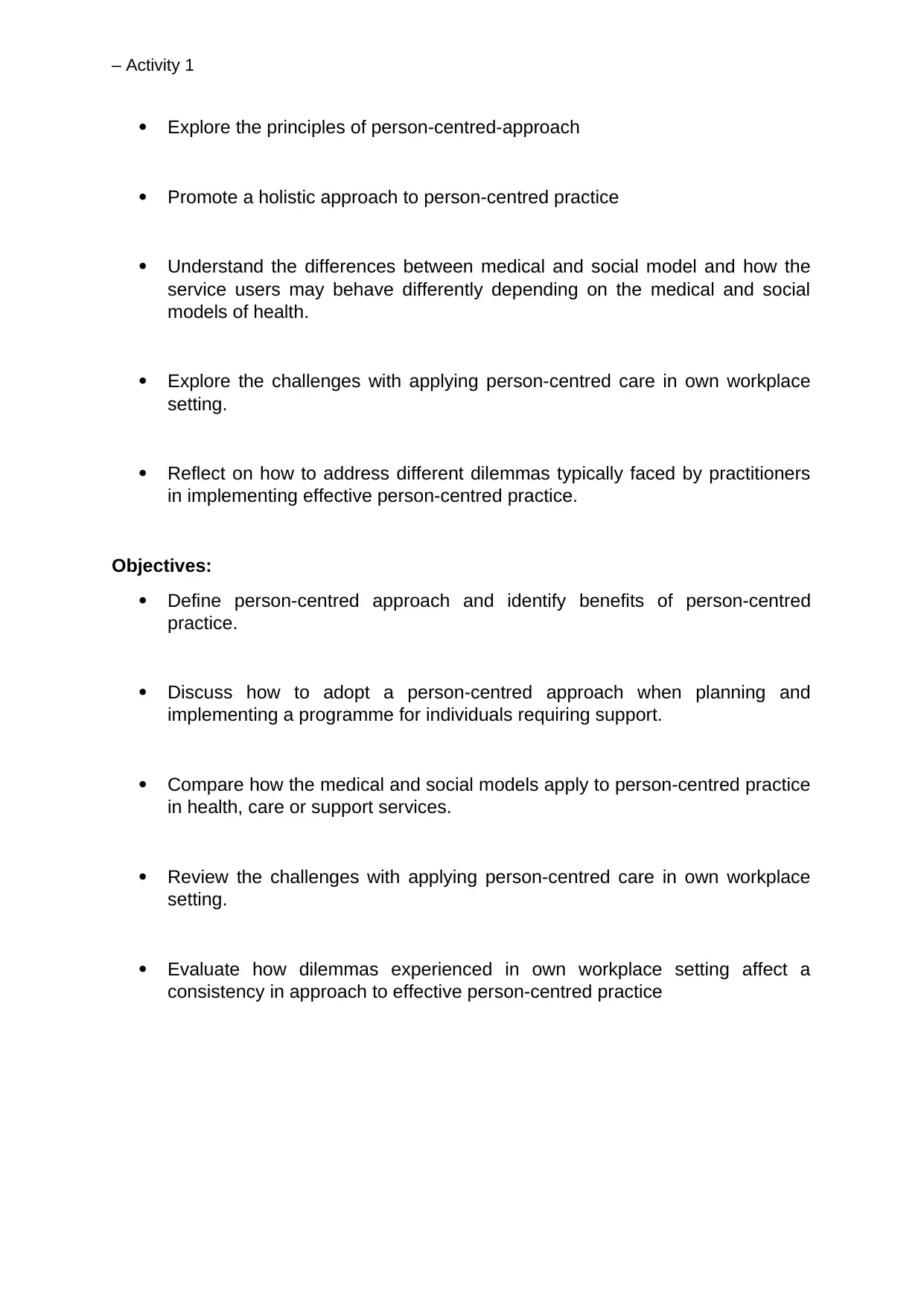
– Activity 1
Explore the principles of person-centred-approach
Promote a holistic approach to person-centred practice
Understand the differences between medical and social model and how the
service users may behave differently depending on the medical and social
models of health.
Explore the challenges with applying person-centred care in own workplace
setting.
Reflect on how to address different dilemmas typically faced by practitioners
in implementing effective person-centred practice.
Objectives:
Define person-centred approach and identify benefits of person-centred
practice.
Discuss how to adopt a person-centred approach when planning and
implementing a programme for individuals requiring support.
Compare how the medical and social models apply to person-centred practice
in health, care or support services.
Review the challenges with applying person-centred care in own workplace
setting.
Evaluate how dilemmas experienced in own workplace setting affect a
consistency in approach to effective person-centred practice
Explore the principles of person-centred-approach
Promote a holistic approach to person-centred practice
Understand the differences between medical and social model and how the
service users may behave differently depending on the medical and social
models of health.
Explore the challenges with applying person-centred care in own workplace
setting.
Reflect on how to address different dilemmas typically faced by practitioners
in implementing effective person-centred practice.
Objectives:
Define person-centred approach and identify benefits of person-centred
practice.
Discuss how to adopt a person-centred approach when planning and
implementing a programme for individuals requiring support.
Compare how the medical and social models apply to person-centred practice
in health, care or support services.
Review the challenges with applying person-centred care in own workplace
setting.
Evaluate how dilemmas experienced in own workplace setting affect a
consistency in approach to effective person-centred practice
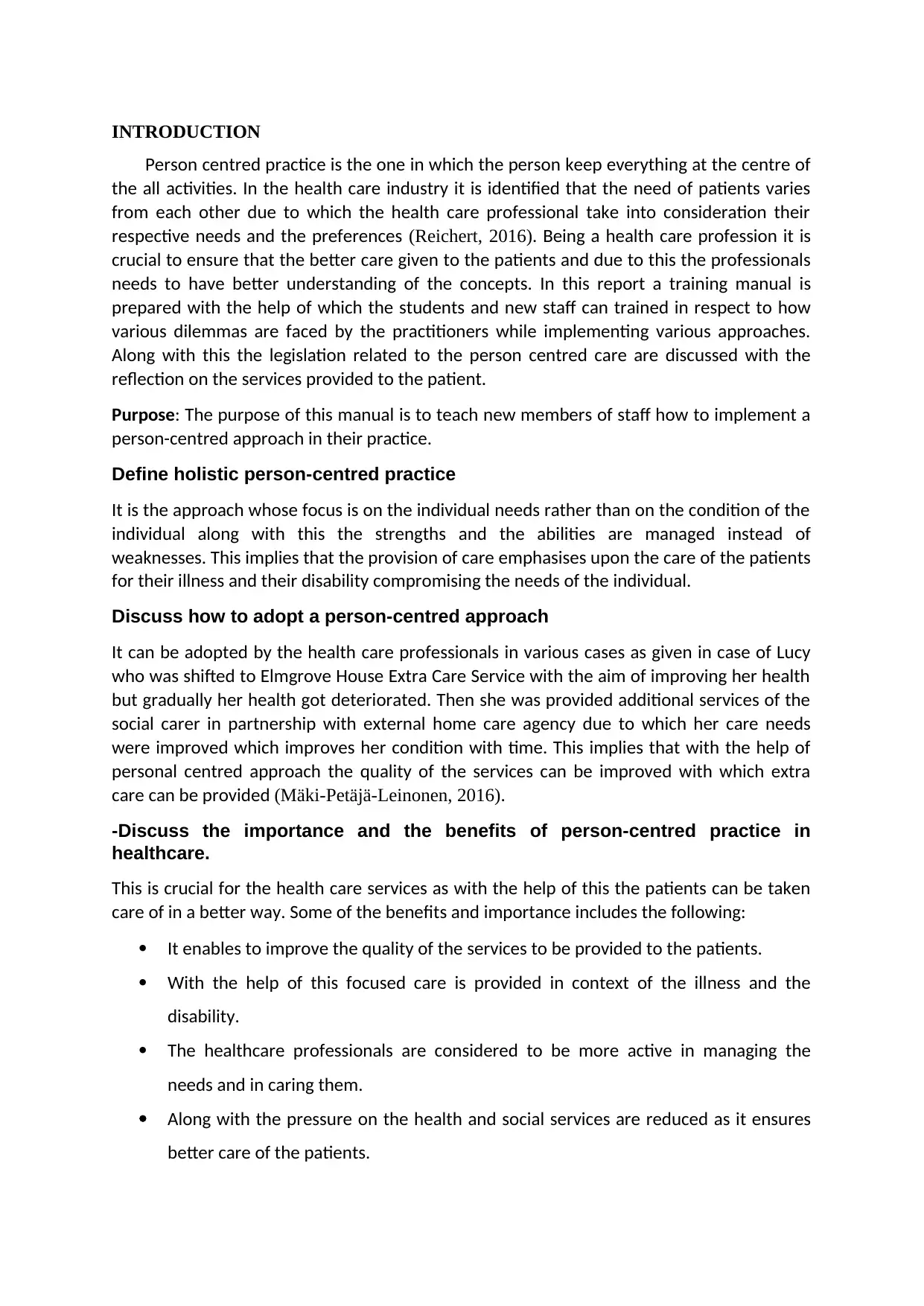
INTRODUCTION
Person centred practice is the one in which the person keep everything at the centre of
the all activities. In the health care industry it is identified that the need of patients varies
from each other due to which the health care professional take into consideration their
respective needs and the preferences (Reichert, 2016). Being a health care profession it is
crucial to ensure that the better care given to the patients and due to this the professionals
needs to have better understanding of the concepts. In this report a training manual is
prepared with the help of which the students and new staff can trained in respect to how
various dilemmas are faced by the practitioners while implementing various approaches.
Along with this the legislation related to the person centred care are discussed with the
reflection on the services provided to the patient.
Purpose: The purpose of this manual is to teach new members of staff how to implement a
person-centred approach in their practice.
Define holistic person-centred practice
It is the approach whose focus is on the individual needs rather than on the condition of the
individual along with this the strengths and the abilities are managed instead of
weaknesses. This implies that the provision of care emphasises upon the care of the patients
for their illness and their disability compromising the needs of the individual.
Discuss how to adopt a person-centred approach
It can be adopted by the health care professionals in various cases as given in case of Lucy
who was shifted to Elmgrove House Extra Care Service with the aim of improving her health
but gradually her health got deteriorated. Then she was provided additional services of the
social carer in partnership with external home care agency due to which her care needs
were improved which improves her condition with time. This implies that with the help of
personal centred approach the quality of the services can be improved with which extra
care can be provided (Mäki-Petäjä-Leinonen, 2016).
-Discuss the importance and the benefits of person-centred practice in
healthcare.
This is crucial for the health care services as with the help of this the patients can be taken
care of in a better way. Some of the benefits and importance includes the following:
It enables to improve the quality of the services to be provided to the patients.
With the help of this focused care is provided in context of the illness and the
disability.
The healthcare professionals are considered to be more active in managing the
needs and in caring them.
Along with the pressure on the health and social services are reduced as it ensures
better care of the patients.
Person centred practice is the one in which the person keep everything at the centre of
the all activities. In the health care industry it is identified that the need of patients varies
from each other due to which the health care professional take into consideration their
respective needs and the preferences (Reichert, 2016). Being a health care profession it is
crucial to ensure that the better care given to the patients and due to this the professionals
needs to have better understanding of the concepts. In this report a training manual is
prepared with the help of which the students and new staff can trained in respect to how
various dilemmas are faced by the practitioners while implementing various approaches.
Along with this the legislation related to the person centred care are discussed with the
reflection on the services provided to the patient.
Purpose: The purpose of this manual is to teach new members of staff how to implement a
person-centred approach in their practice.
Define holistic person-centred practice
It is the approach whose focus is on the individual needs rather than on the condition of the
individual along with this the strengths and the abilities are managed instead of
weaknesses. This implies that the provision of care emphasises upon the care of the patients
for their illness and their disability compromising the needs of the individual.
Discuss how to adopt a person-centred approach
It can be adopted by the health care professionals in various cases as given in case of Lucy
who was shifted to Elmgrove House Extra Care Service with the aim of improving her health
but gradually her health got deteriorated. Then she was provided additional services of the
social carer in partnership with external home care agency due to which her care needs
were improved which improves her condition with time. This implies that with the help of
personal centred approach the quality of the services can be improved with which extra
care can be provided (Mäki-Petäjä-Leinonen, 2016).
-Discuss the importance and the benefits of person-centred practice in
healthcare.
This is crucial for the health care services as with the help of this the patients can be taken
care of in a better way. Some of the benefits and importance includes the following:
It enables to improve the quality of the services to be provided to the patients.
With the help of this focused care is provided in context of the illness and the
disability.
The healthcare professionals are considered to be more active in managing the
needs and in caring them.
Along with the pressure on the health and social services are reduced as it ensures
better care of the patients.
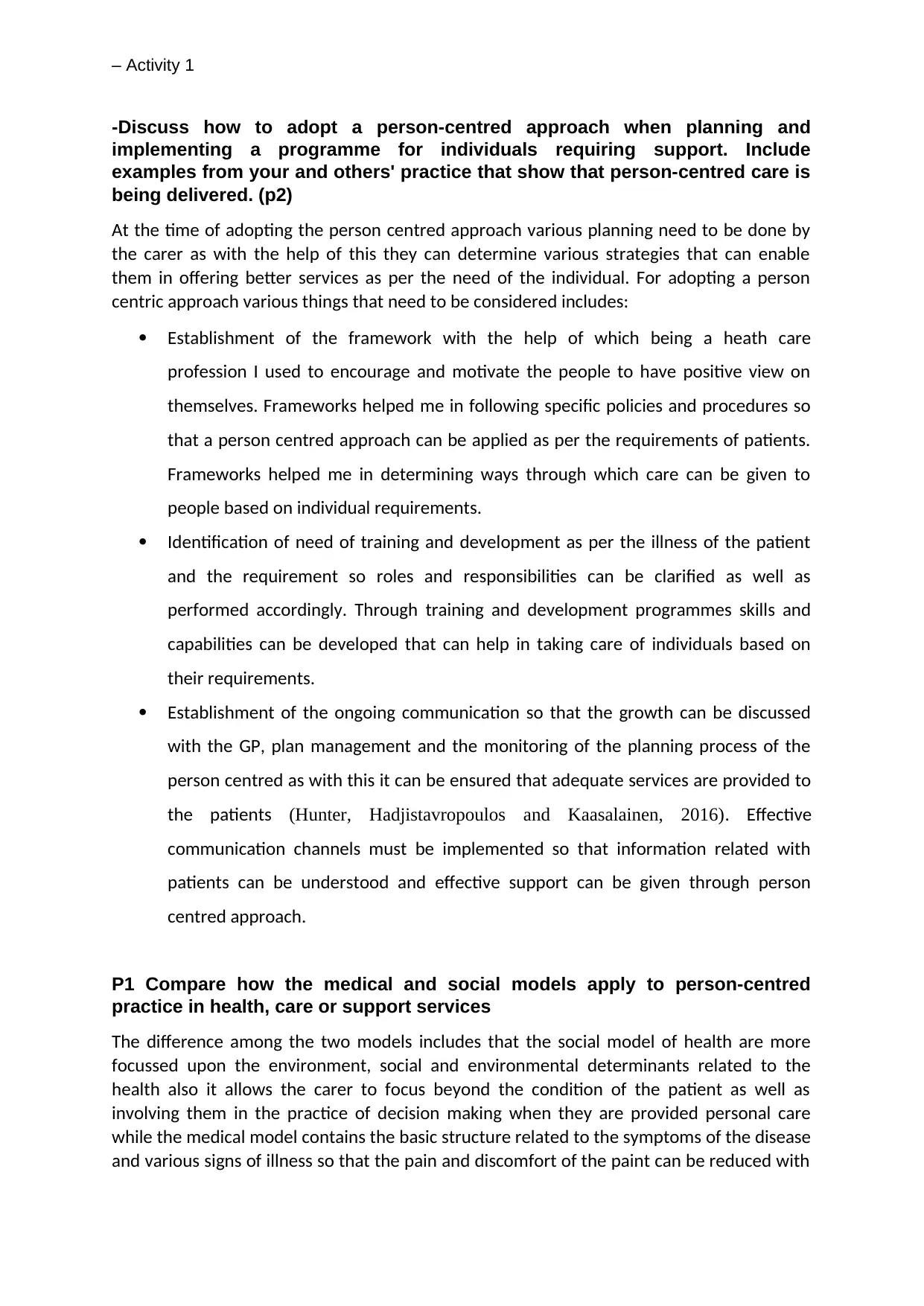
– Activity 1
-Discuss how to adopt a person-centred approach when planning and
implementing a programme for individuals requiring support. Include
examples from your and others' practice that show that person-centred care is
being delivered. (p2)
At the time of adopting the person centred approach various planning need to be done by
the carer as with the help of this they can determine various strategies that can enable
them in offering better services as per the need of the individual. For adopting a person
centric approach various things that need to be considered includes:
Establishment of the framework with the help of which being a heath care
profession I used to encourage and motivate the people to have positive view on
themselves. Frameworks helped me in following specific policies and procedures so
that a person centred approach can be applied as per the requirements of patients.
Frameworks helped me in determining ways through which care can be given to
people based on individual requirements.
Identification of need of training and development as per the illness of the patient
and the requirement so roles and responsibilities can be clarified as well as
performed accordingly. Through training and development programmes skills and
capabilities can be developed that can help in taking care of individuals based on
their requirements.
Establishment of the ongoing communication so that the growth can be discussed
with the GP, plan management and the monitoring of the planning process of the
person centred as with this it can be ensured that adequate services are provided to
the patients (Hunter, Hadjistavropoulos and Kaasalainen, 2016). Effective
communication channels must be implemented so that information related with
patients can be understood and effective support can be given through person
centred approach.
P1 Compare how the medical and social models apply to person-centred
practice in health, care or support services
The difference among the two models includes that the social model of health are more
focussed upon the environment, social and environmental determinants related to the
health also it allows the carer to focus beyond the condition of the patient as well as
involving them in the practice of decision making when they are provided personal care
while the medical model contains the basic structure related to the symptoms of the disease
and various signs of illness so that the pain and discomfort of the paint can be reduced with
-Discuss how to adopt a person-centred approach when planning and
implementing a programme for individuals requiring support. Include
examples from your and others' practice that show that person-centred care is
being delivered. (p2)
At the time of adopting the person centred approach various planning need to be done by
the carer as with the help of this they can determine various strategies that can enable
them in offering better services as per the need of the individual. For adopting a person
centric approach various things that need to be considered includes:
Establishment of the framework with the help of which being a heath care
profession I used to encourage and motivate the people to have positive view on
themselves. Frameworks helped me in following specific policies and procedures so
that a person centred approach can be applied as per the requirements of patients.
Frameworks helped me in determining ways through which care can be given to
people based on individual requirements.
Identification of need of training and development as per the illness of the patient
and the requirement so roles and responsibilities can be clarified as well as
performed accordingly. Through training and development programmes skills and
capabilities can be developed that can help in taking care of individuals based on
their requirements.
Establishment of the ongoing communication so that the growth can be discussed
with the GP, plan management and the monitoring of the planning process of the
person centred as with this it can be ensured that adequate services are provided to
the patients (Hunter, Hadjistavropoulos and Kaasalainen, 2016). Effective
communication channels must be implemented so that information related with
patients can be understood and effective support can be given through person
centred approach.
P1 Compare how the medical and social models apply to person-centred
practice in health, care or support services
The difference among the two models includes that the social model of health are more
focussed upon the environment, social and environmental determinants related to the
health also it allows the carer to focus beyond the condition of the patient as well as
involving them in the practice of decision making when they are provided personal care
while the medical model contains the basic structure related to the symptoms of the disease
and various signs of illness so that the pain and discomfort of the paint can be reduced with
Paraphrase This Document
Need a fresh take? Get an instant paraphrase of this document with our AI Paraphraser
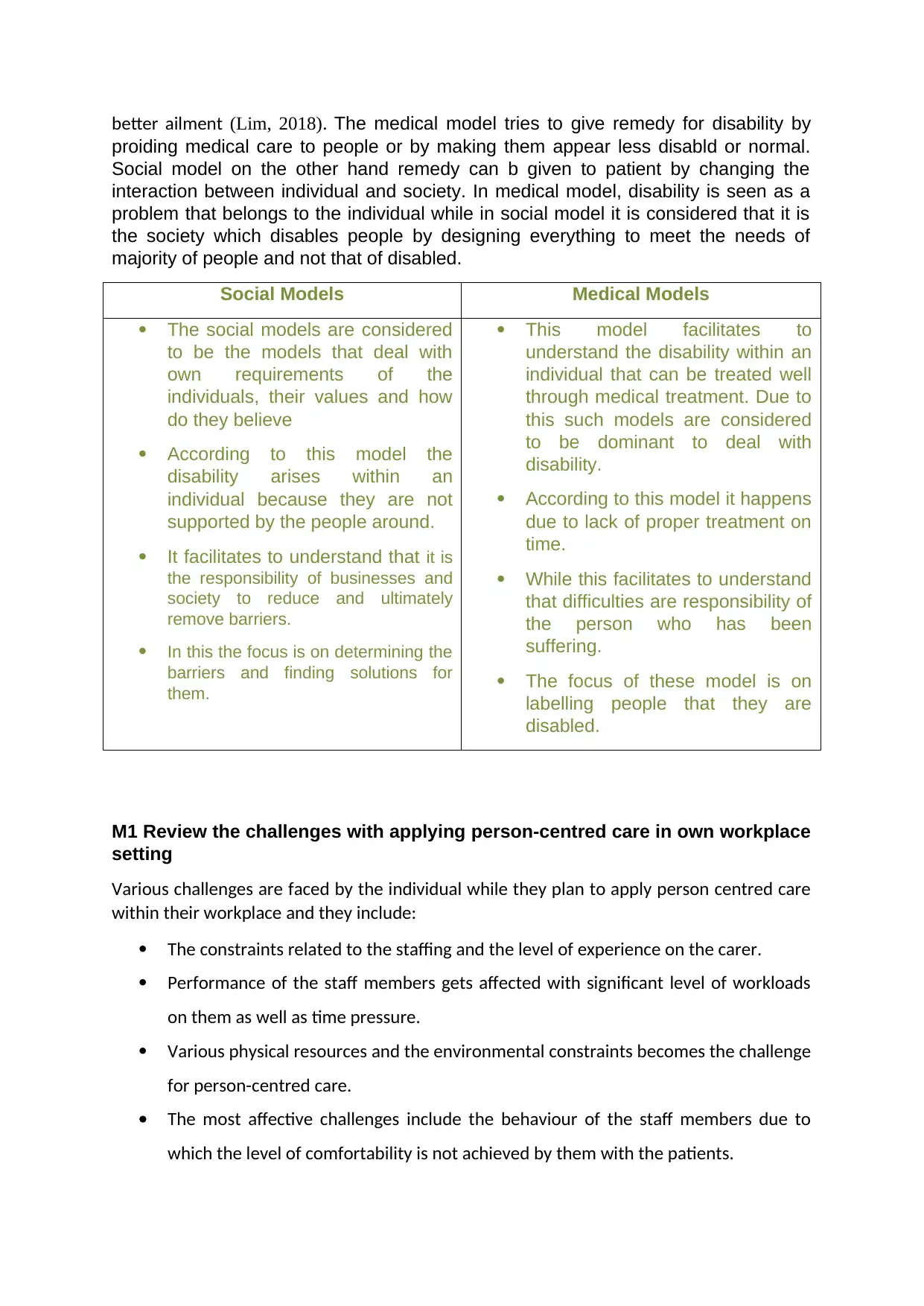
better ailment (Lim, 2018). The medical model tries to give remedy for disability by
proiding medical care to people or by making them appear less disabld or normal.
Social model on the other hand remedy can b given to patient by changing the
interaction between individual and society. In medical model, disability is seen as a
problem that belongs to the individual while in social model it is considered that it is
the society which disables people by designing everything to meet the needs of
majority of people and not that of disabled.
Social Models Medical Models
The social models are considered
to be the models that deal with
own requirements of the
individuals, their values and how
do they believe
According to this model the
disability arises within an
individual because they are not
supported by the people around.
It facilitates to understand that it is
the responsibility of businesses and
society to reduce and ultimately
remove barriers.
In this the focus is on determining the
barriers and finding solutions for
them.
This model facilitates to
understand the disability within an
individual that can be treated well
through medical treatment. Due to
this such models are considered
to be dominant to deal with
disability.
According to this model it happens
due to lack of proper treatment on
time.
While this facilitates to understand
that difficulties are responsibility of
the person who has been
suffering.
The focus of these model is on
labelling people that they are
disabled.
M1 Review the challenges with applying person-centred care in own workplace
setting
Various challenges are faced by the individual while they plan to apply person centred care
within their workplace and they include:
The constraints related to the staffing and the level of experience on the carer.
Performance of the staff members gets affected with significant level of workloads
on them as well as time pressure.
Various physical resources and the environmental constraints becomes the challenge
for person-centred care.
The most affective challenges include the behaviour of the staff members due to
which the level of comfortability is not achieved by them with the patients.
proiding medical care to people or by making them appear less disabld or normal.
Social model on the other hand remedy can b given to patient by changing the
interaction between individual and society. In medical model, disability is seen as a
problem that belongs to the individual while in social model it is considered that it is
the society which disables people by designing everything to meet the needs of
majority of people and not that of disabled.
Social Models Medical Models
The social models are considered
to be the models that deal with
own requirements of the
individuals, their values and how
do they believe
According to this model the
disability arises within an
individual because they are not
supported by the people around.
It facilitates to understand that it is
the responsibility of businesses and
society to reduce and ultimately
remove barriers.
In this the focus is on determining the
barriers and finding solutions for
them.
This model facilitates to
understand the disability within an
individual that can be treated well
through medical treatment. Due to
this such models are considered
to be dominant to deal with
disability.
According to this model it happens
due to lack of proper treatment on
time.
While this facilitates to understand
that difficulties are responsibility of
the person who has been
suffering.
The focus of these model is on
labelling people that they are
disabled.
M1 Review the challenges with applying person-centred care in own workplace
setting
Various challenges are faced by the individual while they plan to apply person centred care
within their workplace and they include:
The constraints related to the staffing and the level of experience on the carer.
Performance of the staff members gets affected with significant level of workloads
on them as well as time pressure.
Various physical resources and the environmental constraints becomes the challenge
for person-centred care.
The most affective challenges include the behaviour of the staff members due to
which the level of comfortability is not achieved by them with the patients.

– Activity 1
Illustrate a resource that can be used for an activity in training staff and
students on how to address different dilemmas typically faced by practitioners
in implementing effective person-centred practice
The activity that can provide better understanding of the situation to the staff can be by
taking them to the centre where the patients are treated or they can sent with the social
carer to assist them for some time as with the help of this they can determine various
dilemmas that they have to faced whiling implementing the person centred practices. Also
various sessions can be organised for them so that people already facing the dilemmas can
share their experience along with its impact on the overall implementation (Feo and Kitson,
2017).
D1 Evaluate how dilemmas experienced in own workplace setting affect a
consistency in approach to effective person-centred practice
The dilemmas are experienced by the professions within the workplace due to various
factors such as emerging technology in context of tracking devices etc. due to which the
ethical dilemmas are faced because it leads them to faced various problems related to use
of various technology for treating the patients, use of privacy for treating their issues, risk
related to telling them the truth and many more. All these have direct impact on the
workplace setting as the reasons for the dementia and mental patients are diversified which
put the professions in dilemma in context of the strategy to treat them as assistive
technology can affect the behaviour also the desire of level of trust that the patient wants to
develop with the carer becomes the ethical reason for dilemma. All these have direct
influence on the services that has been offered to them.
References:
Feo, R., Conroy, T., Marshall, R.J., Rasmussen, P., Wiechula, R. and Kitson, A.L., 2017.
Using holistic interpretive synthesis to create practice‐relevant guidance for person‐
centred fundamental care delivered by nurses. Nursing inquiry, 24(2), p.e12152.
Hunter, P.V., Hadjistavropoulos, T. and Kaasalainen, S., 2016. A qualitative study of nursing
assistants' awareness of person-centred approaches to dementia care. Ageing &
Society, 36(6), pp.1211-1237.
Illustrate a resource that can be used for an activity in training staff and
students on how to address different dilemmas typically faced by practitioners
in implementing effective person-centred practice
The activity that can provide better understanding of the situation to the staff can be by
taking them to the centre where the patients are treated or they can sent with the social
carer to assist them for some time as with the help of this they can determine various
dilemmas that they have to faced whiling implementing the person centred practices. Also
various sessions can be organised for them so that people already facing the dilemmas can
share their experience along with its impact on the overall implementation (Feo and Kitson,
2017).
D1 Evaluate how dilemmas experienced in own workplace setting affect a
consistency in approach to effective person-centred practice
The dilemmas are experienced by the professions within the workplace due to various
factors such as emerging technology in context of tracking devices etc. due to which the
ethical dilemmas are faced because it leads them to faced various problems related to use
of various technology for treating the patients, use of privacy for treating their issues, risk
related to telling them the truth and many more. All these have direct impact on the
workplace setting as the reasons for the dementia and mental patients are diversified which
put the professions in dilemma in context of the strategy to treat them as assistive
technology can affect the behaviour also the desire of level of trust that the patient wants to
develop with the carer becomes the ethical reason for dilemma. All these have direct
influence on the services that has been offered to them.
References:
Feo, R., Conroy, T., Marshall, R.J., Rasmussen, P., Wiechula, R. and Kitson, A.L., 2017.
Using holistic interpretive synthesis to create practice‐relevant guidance for person‐
centred fundamental care delivered by nurses. Nursing inquiry, 24(2), p.e12152.
Hunter, P.V., Hadjistavropoulos, T. and Kaasalainen, S., 2016. A qualitative study of nursing
assistants' awareness of person-centred approaches to dementia care. Ageing &
Society, 36(6), pp.1211-1237.
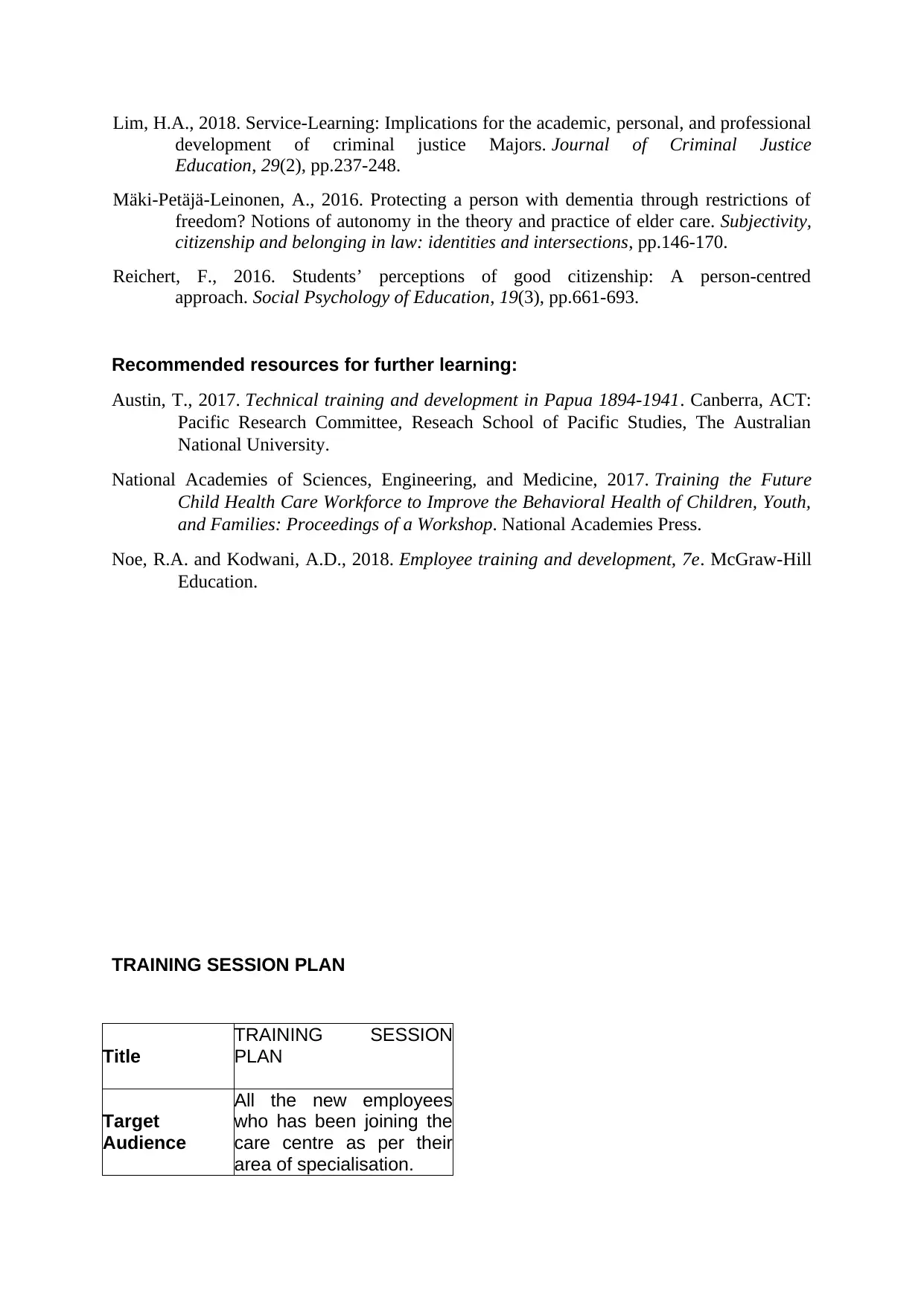
Lim, H.A., 2018. Service-Learning: Implications for the academic, personal, and professional
development of criminal justice Majors. Journal of Criminal Justice
Education, 29(2), pp.237-248.
Mäki-Petäjä-Leinonen, A., 2016. Protecting a person with dementia through restrictions of
freedom? Notions of autonomy in the theory and practice of elder care. Subjectivity,
citizenship and belonging in law: identities and intersections, pp.146-170.
Reichert, F., 2016. Students’ perceptions of good citizenship: A person-centred
approach. Social Psychology of Education, 19(3), pp.661-693.
Recommended resources for further learning:
Austin, T., 2017. Technical training and development in Papua 1894-1941. Canberra, ACT:
Pacific Research Committee, Reseach School of Pacific Studies, The Australian
National University.
National Academies of Sciences, Engineering, and Medicine, 2017. Training the Future
Child Health Care Workforce to Improve the Behavioral Health of Children, Youth,
and Families: Proceedings of a Workshop. National Academies Press.
Noe, R.A. and Kodwani, A.D., 2018. Employee training and development, 7e. McGraw-Hill
Education.
TRAINING SESSION PLAN
Title
TRAINING SESSION
PLAN
Target
Audience
All the new employees
who has been joining the
care centre as per their
area of specialisation.
development of criminal justice Majors. Journal of Criminal Justice
Education, 29(2), pp.237-248.
Mäki-Petäjä-Leinonen, A., 2016. Protecting a person with dementia through restrictions of
freedom? Notions of autonomy in the theory and practice of elder care. Subjectivity,
citizenship and belonging in law: identities and intersections, pp.146-170.
Reichert, F., 2016. Students’ perceptions of good citizenship: A person-centred
approach. Social Psychology of Education, 19(3), pp.661-693.
Recommended resources for further learning:
Austin, T., 2017. Technical training and development in Papua 1894-1941. Canberra, ACT:
Pacific Research Committee, Reseach School of Pacific Studies, The Australian
National University.
National Academies of Sciences, Engineering, and Medicine, 2017. Training the Future
Child Health Care Workforce to Improve the Behavioral Health of Children, Youth,
and Families: Proceedings of a Workshop. National Academies Press.
Noe, R.A. and Kodwani, A.D., 2018. Employee training and development, 7e. McGraw-Hill
Education.
TRAINING SESSION PLAN
Title
TRAINING SESSION
PLAN
Target
Audience
All the new employees
who has been joining the
care centre as per their
area of specialisation.
Secure Best Marks with AI Grader
Need help grading? Try our AI Grader for instant feedback on your assignments.

– Activity 1
Purpose
The purpose of this
manual is to teach new
members of staff how to
implement a person-
centred approach in their
practice.
Instructor
Team leaders and experts
from the industry along with
human resource managers
Prerequisites
Location
The seminar hall within the
institution
Date
and Time
Learning
Outcomes: The
outcomes of the
report will be the
ability of the staff to
manage the
requirements of the
patients with various
skills such as they
will get to know
various approaches
with which impact on
wellbeing can be
reflected in their own
practice.
Learning
Objectives: The
purpose of this
manual is to teach
new members of
staff how to
implement a person-
centred approach in
their practice as with
the help of this they
can ensure that all
the members who
have joined the
organsiation are able
to provide the
services to the
patients as per their
expectations and
need.
Purpose
The purpose of this
manual is to teach new
members of staff how to
implement a person-
centred approach in their
practice.
Instructor
Team leaders and experts
from the industry along with
human resource managers
Prerequisites
Location
The seminar hall within the
institution
Date
and Time
Learning
Outcomes: The
outcomes of the
report will be the
ability of the staff to
manage the
requirements of the
patients with various
skills such as they
will get to know
various approaches
with which impact on
wellbeing can be
reflected in their own
practice.
Learning
Objectives: The
purpose of this
manual is to teach
new members of
staff how to
implement a person-
centred approach in
their practice as with
the help of this they
can ensure that all
the members who
have joined the
organsiation are able
to provide the
services to the
patients as per their
expectations and
need.
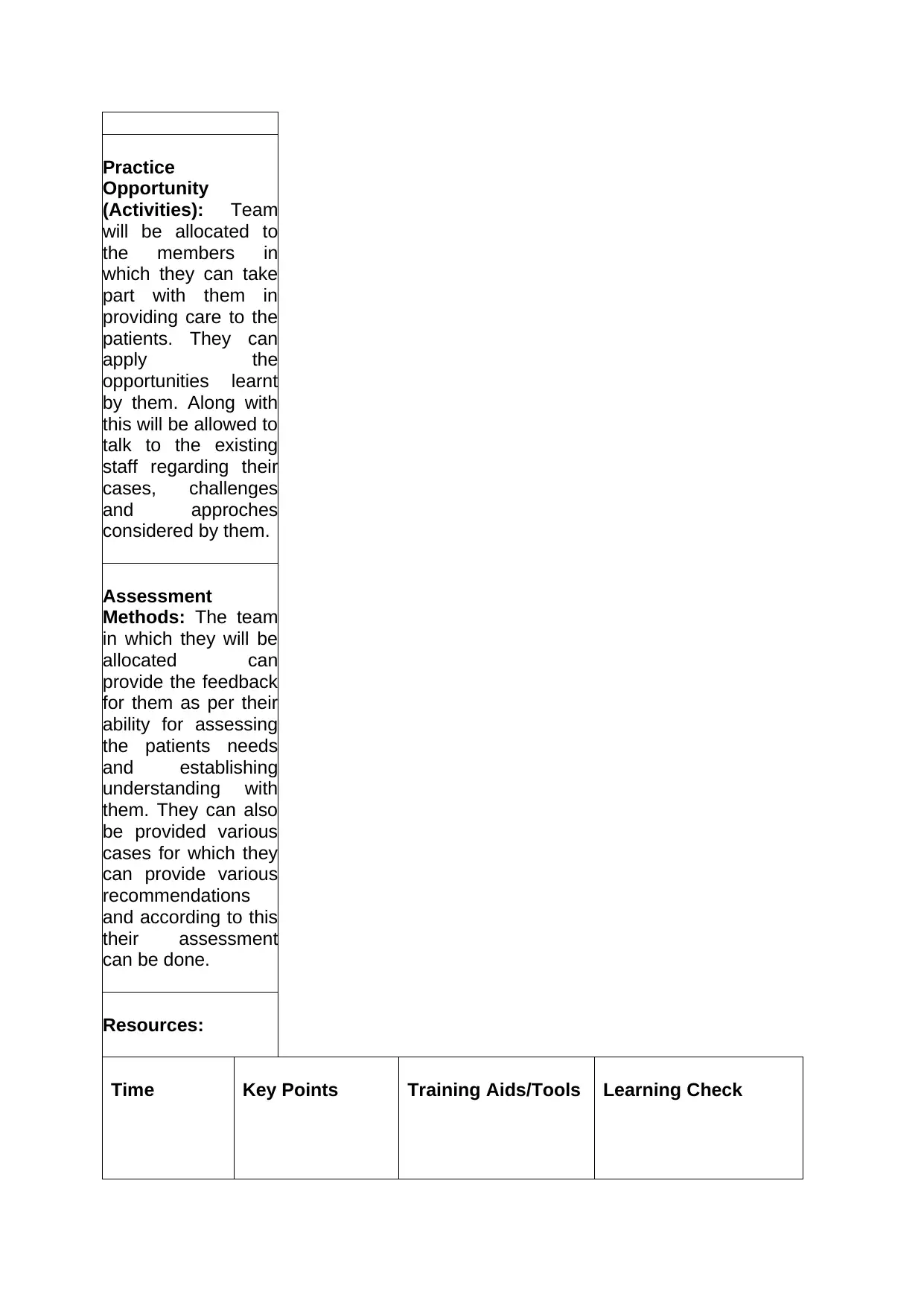
Practice
Opportunity
(Activities): Team
will be allocated to
the members in
which they can take
part with them in
providing care to the
patients. They can
apply the
opportunities learnt
by them. Along with
this will be allowed to
talk to the existing
staff regarding their
cases, challenges
and approches
considered by them.
Assessment
Methods: The team
in which they will be
allocated can
provide the feedback
for them as per their
ability for assessing
the patients needs
and establishing
understanding with
them. They can also
be provided various
cases for which they
can provide various
recommendations
and according to this
their assessment
can be done.
Resources:
Time Key Points Training Aids/Tools Learning Check
Opportunity
(Activities): Team
will be allocated to
the members in
which they can take
part with them in
providing care to the
patients. They can
apply the
opportunities learnt
by them. Along with
this will be allowed to
talk to the existing
staff regarding their
cases, challenges
and approches
considered by them.
Assessment
Methods: The team
in which they will be
allocated can
provide the feedback
for them as per their
ability for assessing
the patients needs
and establishing
understanding with
them. They can also
be provided various
cases for which they
can provide various
recommendations
and according to this
their assessment
can be done.
Resources:
Time Key Points Training Aids/Tools Learning Check

– Activity 1
Within 2
weeks
Better
understanding of
the issues faced
by the patients
and their
expectations
Cases studies of the
patients along with
their issues and
problems
The ability to
understand the case
and its requirement
Within 1
month
Better interaction
with the GP of the
patients and
other related
parties
Seminars and
workshops by the
experts so that they
can make them learn
how to deal with the
issues. In addition to
this the
communication with
the GP and other
related parties
through such
workshops.
The efficiency in
reporting to the GP of
the patients can be
analysed as with this
the abilities can be
evaluated.
Within 2
weeks
Better
understanding of
the issues faced
by the patients
and their
expectations
Cases studies of the
patients along with
their issues and
problems
The ability to
understand the case
and its requirement
Within 1
month
Better interaction
with the GP of the
patients and
other related
parties
Seminars and
workshops by the
experts so that they
can make them learn
how to deal with the
issues. In addition to
this the
communication with
the GP and other
related parties
through such
workshops.
The efficiency in
reporting to the GP of
the patients can be
analysed as with this
the abilities can be
evaluated.
1 out of 13
Related Documents
Your All-in-One AI-Powered Toolkit for Academic Success.
+13062052269
info@desklib.com
Available 24*7 on WhatsApp / Email
![[object Object]](/_next/static/media/star-bottom.7253800d.svg)
Unlock your academic potential
© 2024 | Zucol Services PVT LTD | All rights reserved.





